(Strand)om Stories: Silver Surfer: Parable Review
Lofty ideas can't quite hit the mark given the quick pacing driving this two-issue series
—by Nathan on June 16, 2024—
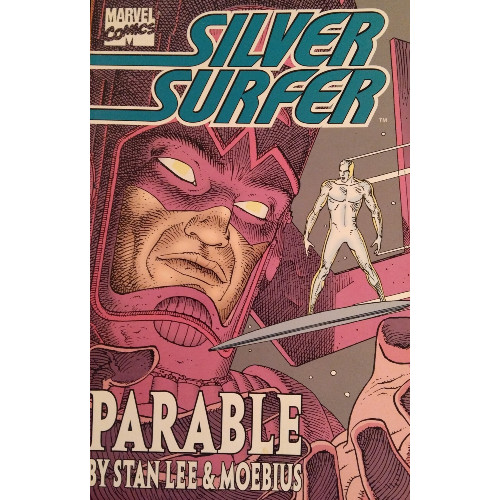
Since his inception during the famed "Galactus Trilogy," the Silver Surfer has always been a unique fella. With his silver sheen glinting in the sun, soaring through the cosmos on his space-faring surfboard, Norrin Radd's aluminum pigmented alter ego is a wandering philosopher, discontent with the state of regular Earthbound existence (and sometimes not too pleased with us foolish mortals), happiest when he can freely slice through the stars. For a time, writer Stan Lee and artist Jack Kirby squashed his hopes of sailing unfettered, forcing him to mingle with humanity, where his lengthy exile kept him from the farthest reaches he so loved. The irony should not be lost on readers: the action which freed the Surfer from Galactus' thrall imprisoned him on Earth. For a time. The Surfer, at some point, would soar the stars again and face intergalactic foes.
A little over twenty years after his debut (and approximately twenty years after he received his first series), the Silver Surfer met up again with co-creator Stan Lee. Though Galactus gave Norrin Radd the power cosmic, it was Lee who developed his story, with a doubtlessly integral helping hand from Jack Kirby, who conceptualized, designed, and breathed life into the character. Teaming this time with French artist Moebius, Lee constructed a new narrative around the Earthbound Surfer, positing what would happen were Galactus to visit our world again after promising to not nibble our countries and quaff our oceans. Published under Marvel's now-defunct version of Vertigo, Epic Comics, Parable is intended to be a powerful, two-issue premiere series which strikes at the core of who we are as a people…and how we're seen through the shimmering eyes of the Silver Surfer.
Silver Surfer: Parable
Writer: Stan Lee
Penciler: Moebius
Inker: Moebius
Colorists: Moebius, John Wellington
Letterer: Moebius
Issues Collected: Silver Surfer: Parable #1-2
Volume Publication Date: February 1998
Issue Publication Dates: December 1988-January 1989
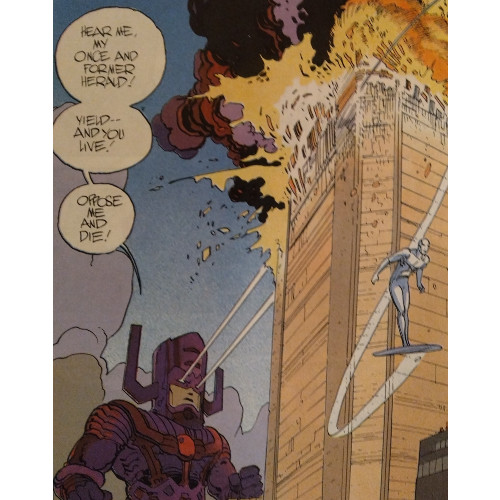
Several years ago, my dad received for Christmas Stan Lee's Amazing Marvel Universe, a book detailing several integral stories published by Marvel during their stories history, most of which were written by Stan Lee (but not all, which is important, because younger me originally believed Lee was the creator of characters like Luke Cage and the 1975 X-Men). Chapters have their own text pieces, but each has an additional audio bit narrated by Lee. The book may nowadays be a little out of date, but if you're interested in hearing how Stan "The Man" Lee himself remembers the creation of the Fantastic Four or the debut of Mary Jane Watson, it's worth a gander. Yes, Lee’s legacy has since been called into question and reevaluated from a less reverent position, particularly in terms of giving credit to other creators, but if you're even a fan of Marvel, I suggest checking it out.
Coming back to our soaring, shining subject at hand, one of those chapters focused on Parable, and it was the first time I had heard of the story. I had no idea it'd be at least 15 years after originally learning of Parable that I'd finally read it, and to be honest, without reading the book, I’m not sure I would have been interested. But periodically, Moebius' art from this two-issue tale flitted through my mind, and I was reminded of his work with Lee. The images I had observed focused on a rampaging Galactus and a Surfer standing against a wrongheaded proselytizer. I felt convinced that a story with such powerful emotions that placed the Surfer in conflict with both false philosophy and his godlike former master was a story too good to pass up.
And it is…conceptually.
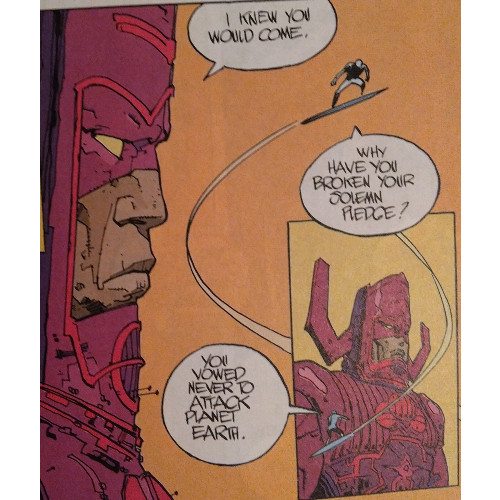
I've noted Lee's writing weaknesses in the past, and in his defense, he avoids some of his typical pitfalls here. There aren’t any ridiculous love triangles. The story's singular important female character is given a semblance of an arc, her personal narrative integral to the series' second issue even if she languishes in the background of the first half. Lee endeavors to offer a philosophically-aware tale commenting on the dangers of mindless religion, solidly landing the plane but delivering a somewhat turbulent flight. Much of this boils down to his overblown style of writing, which doesn't seem to have changed a whole lot since his heyday in the 60s. From the Silver Surfer, to Galactus, to the regular folk inhabiting the pages, characters are prone to hyperbole. You're reading a patented Stan Lee narrative, just embellished by highly detailed art.
At its core, the story could work better than it does. When Galactus arrives on Earth again, pledging peace with humanity, a screwy televangelist calls him God and, for his own selfish benefit, rallies a religion around the Devourer of Worlds. The issues of religion play out interestingly, as Lee sews this concept of selfishness and deceit from a man who, as the narrative unfolds, falls for his own trap, sucked into the heresy he's developed around a "god" who pays him no attention. The Surfer, meanwhile, opposes Galactus' presence, earning the ire of a humanity who believes Galactus can use his power to make a paradise on Earth.
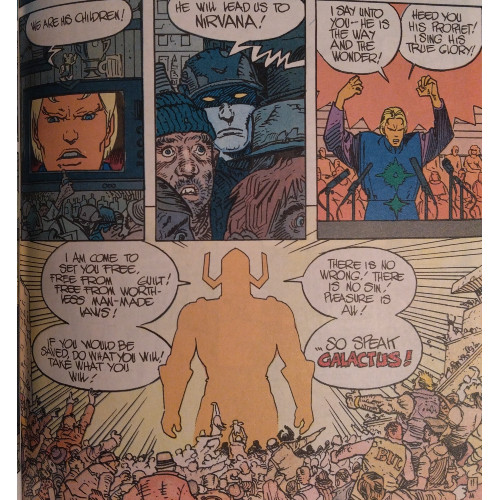
Several interesting strands exist for Lee and Moebius to tug on significantly–Galactus' purposes, the development of a new religion, the Surfer's struggle, the televangelist's deceit, his own sister's wavering belief. Problematically, because this is a two-issue series, Lee struggles with his pacing, forcing all these developments into a handful of pages. "Almost overnight, a new religion has sprung up around the awesome being, making him an object of worship," a reporter tells us immediately after Galactus arrives on Earth, and this is where the narrative begins to buckle. We see no religion develop around Galactus–the Earth is merely tossed into fanatical chaos as people become divided between believing and not believing the cosmic giant claiming to come in peace.
I suppose you can only expect so much out of a story 50 pages long across two issues. Lee has clearly considered the angles he wishes to tackle, which characters are important to focus on, how the plot will wrap up. There are small moments which work–the Silver Surfer saves the life of a man who shot at him earlier; the televangelist rails at Galactus when the Devourer of Worlds fails to answer his pleas; the giant topples buildings in pursuit of the Surfer. Moments across both issues stand out, and Lee ends the series on a fairly significant, satisfying note. It's just the connective tissue between those segments preceding the ending which fail to fully enrapture or inspire. The Surfer is cast into this messianic role, and while the ending sees him fulfilling that role in a surprising, powerful way, the Surfer's Christ-like role in this "parable" is undercut by all the other moving pieces.

None of the narrative's faults can be placed on Moebius, who visualizes Lee's script in a way which can only be described as magnificent. Penciling, inking, coloring (with John Wellington), even lettering, Moebius produces the bulk of the material presented here. His Galactus is strikingly godlike while retaining his distinct humanity in both design and function. He snarls, rages, ponders. Close-up images of his helmet display intricate detail Moebius has wrought from the metalwork–there is almost something cybernetic, even a little worn about the giant's form, less polished than presented by other artists. Modern skyscrapers stretch to heaven, bold and beautiful until they are massacred by the cosmic-wielding Galactus.
Here and there, a few faces look out of place–due to some strange coloring choices, Moebius (or perhaps Wellington) never really commits to the televangelist's ethnicity, developing a line between Indian and Native American which could be crossed either way depending on the panel. He isn't white, that much is clear, and given his ethnicity doesn't play into his development, it may ultimately not matter. But it is a tad confusing at first, especially as he is a central character–I remember thinking this from the moment I first read about this story in Stan Lee's Amazing Marvel Universe, my artistically ignorant brain trying to determine why a character I assumed was the same guy looked so different depending on the panel.
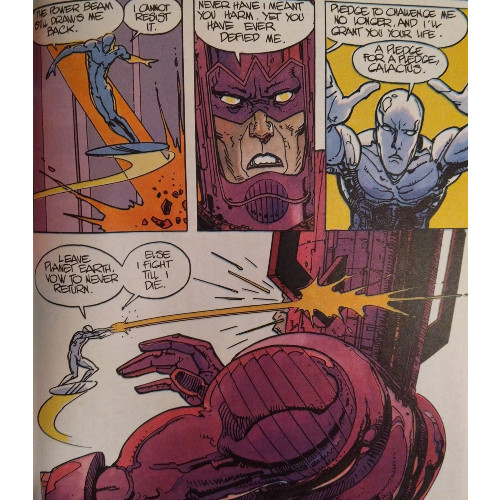
You can find something to love here if you give Parable a shot. Maybe you'll wildly appreciate Moebius' vivid construction of a world on the brink or his absolute colossus of a Galactus. Maybe you'll enjoy Lee's attempts at deeper philosophical ponderings, with notions of religion and hate resembling most closely his and Jack Kirby's inspired Sentinel trilogy in X-Men #14-16. At the same time, you can find things to…not like as much, we'll say. Lee's ideas are large, profound in their scope as he attempts to live up to the series' title. But they become lost in their brevity, the demands of story outpacing his aims, and the deeper notions, particularly in the Surfer's portrayal as this unwanted savior, become blended with all the rest. Flashes of brilliance are found here–you can see part of humanity embodied by the raving televangelist, glimpse another portion represented by his sister, perhaps find yourself in the legions who blindly follow Galactus. But if you're looking for Lee to cultivate a stirring critique of religion's underpinnings, you'll not find that here. We are given too brief a time to consider humanity's condition and their complicity in abusing their saviors in these pages, a more thoughtful perspective lost in the time summed up by the phrase "almost overnight."